Learn the differences between leads, prospects, and opportunities. Understand how to turn leads into prospects and opportunities.
Facebook lead ads are paid social ads with embedded forms that allow leads to enter their information while staying on the Facebook platform. These forms enable B2B and B2C businesses selling almost anything to capture interested leads' key details without sending them off-platform to an external lead generation landing page. This means less friction for the lead and a higher chance they'll fill out your form.
Facebook lead ads help you generate high-quality inbound leads, grow your customer base, amplify your brand, and better understand your audience through exposure and lead capture. When you launch an ad, you offer the lead a valuable lead magnet in return for filling out an attached form with fields such as name, email address, and company. If the answers are part of Facebook’s data, the fields autopopulate; if not, the user fills them in themselves.
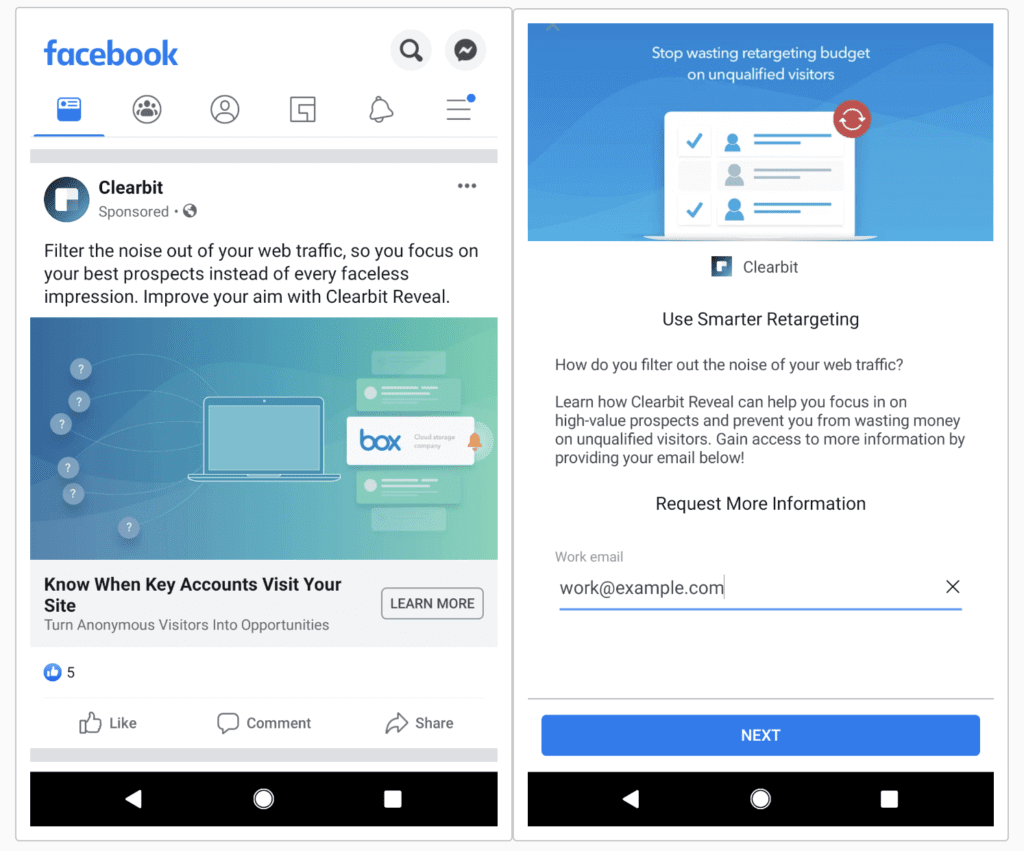
Creating a Facebook lead ad is easy. Just go to Facebook Ads Manager and select "lead generation" as your objective. After creating your new campaign and ad sets, pick your budget, schedule, audience traits, and placements. Then, create the clickable ad in carousel, video, or single image format. Lastly, make the form and select which information you want to collect from your leads.
Overall, lead ads are effective, but they cost an average of $12.07 per 1,000 impressions, so you'll want to be sure you understand their pros and cons, as well as how to make a successful ad. If you'd like a full list of the best free and paid Facebook lead gen strategies, check out our ultimate guide to Facebook lead generation. Otherwise, let’s look at the best use cases for Facebook lead ads and then dive into the specifics on how to create and optimize ones that actually convert.
B2B and B2C companies looking to generate social media leads and grow their customer base directly on the Facebook platform can benefit from lead ads. Businesses selling almost anything can be a good fit for lead ads, but here are some common use cases:
Regardless of your business type and need, Facebook lead ads are often a great paid option for generating quality leads and capturing their information. Now, let’s take a look at how to actually create your Facebook lead ad.
Creating a lead ad is simple, especially if you're familiar with Facebook’s ad platform. The step-by-step process for setting up your Facebook lead gen ads is to create a lead generation campaign and ad set, choose how and when to publish your ad, set your bidding parameters, select who sees your ad and where it shows up, associate your ad with your business page, design your ad media and copy, craft your form, and publish your ad. We'll break these down below.
First, go to your Ads Manager. In the top left corner of Ads Manager, click Create. The button is green, as shown below.
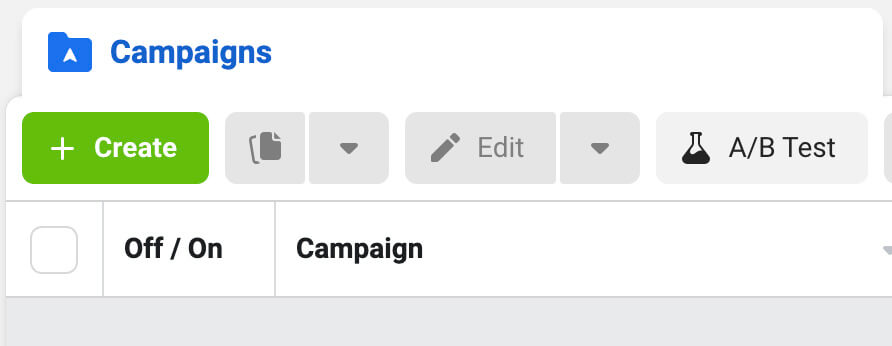
Then, Facebook will prompt you to choose a campaign objective. Select Leads as your objective. When you do, you'll see the option to name your campaign.
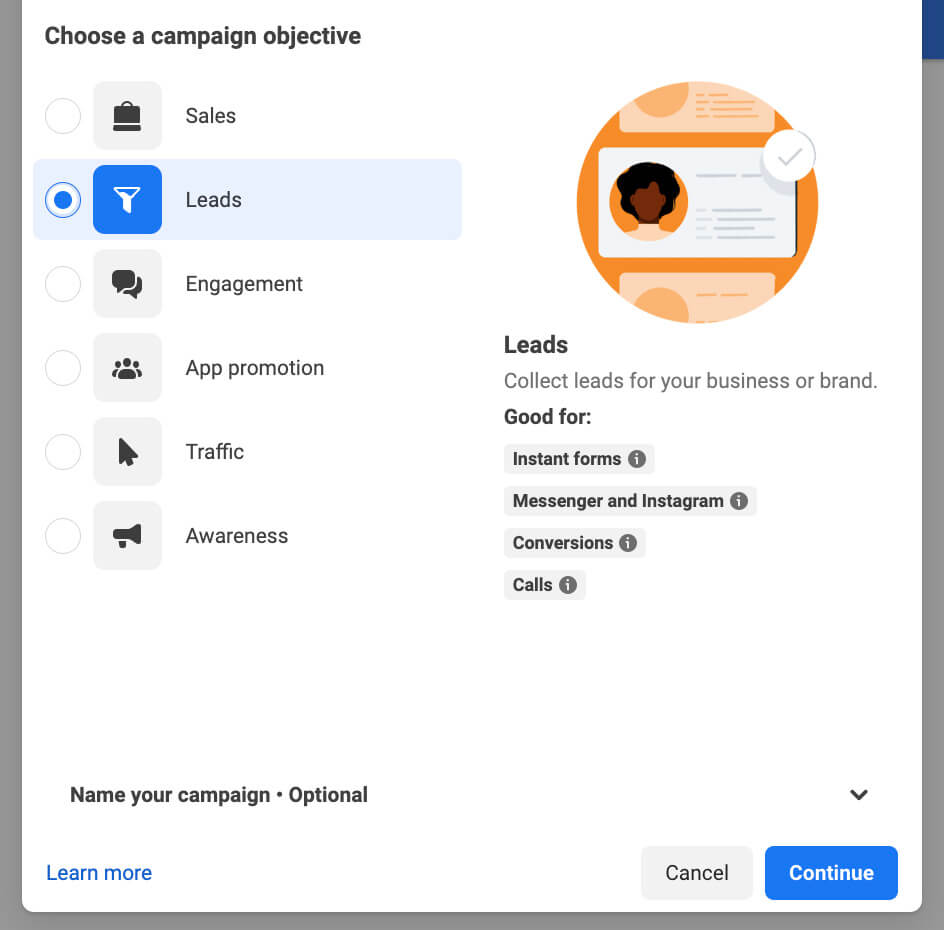
If you didn't name your campaign in the previous step, do so on this next page. Be descriptive here. Include your campaign objective in the name so it’s easy to compare results later on. For example, in the image below, the campaign name is informative — it's the first campaign related to lead generation, and the audience is turtle owners.
After naming your campaign, look through the other sections on this page and decide whether you'd like to choose any of the options given; use the additional information Facebook offers on the page if you're unsure. Then, click Next in the bottom right corner to proceed to your ad set.
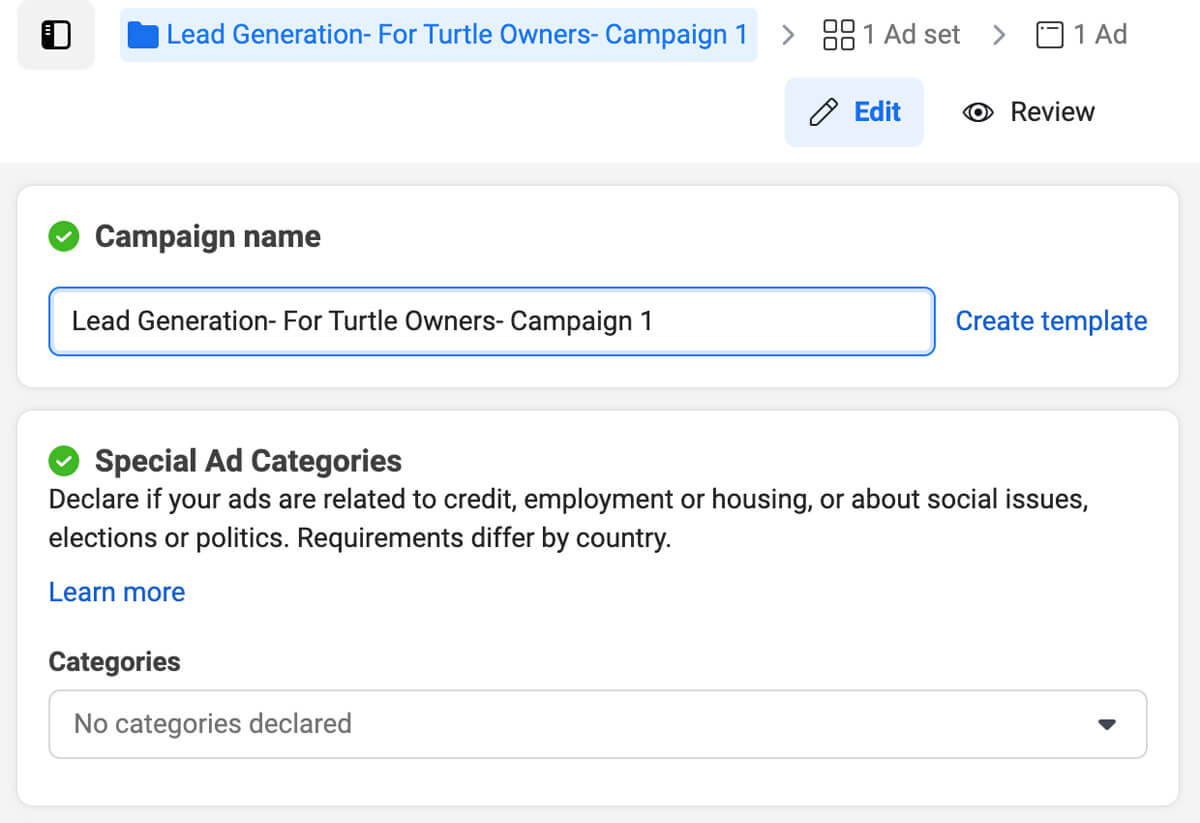
Next, name your ad set. This is a group that will hold all ads for a specific campaign targeting a specific persona. Ad sets will save you time in the future because all new ads you make in the ad set will share settings; you won’t have to do it over. Ideally, include the specific persona in the name, like Turtle Owners in the image below.
Once you choose an ad set name, select how you'd like to connect with people. Forms, chat, and phone are offered; choose Instant Forms to create a Facebook lead ad.
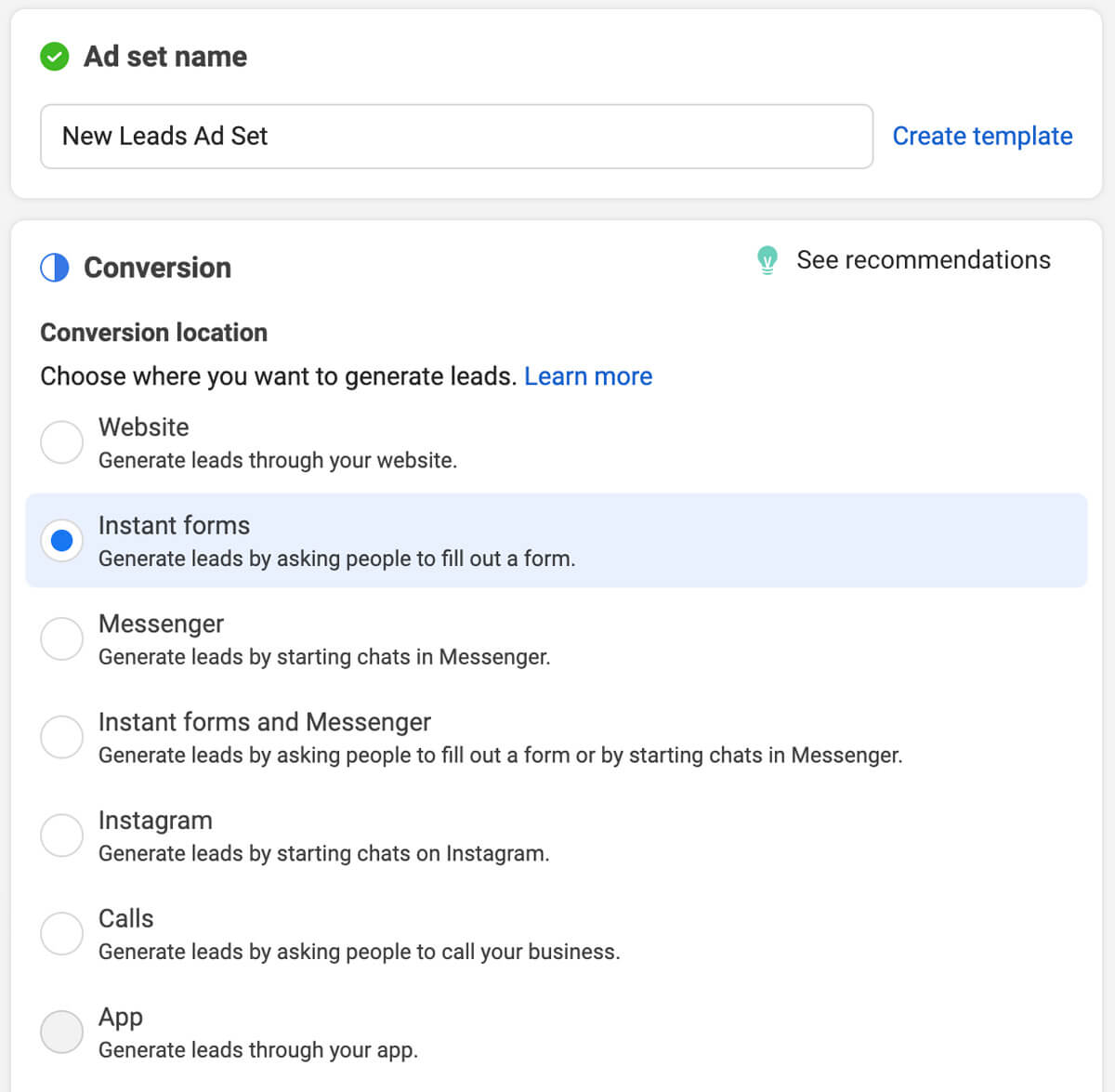
Under Page, choose the page you plan to use for the lead ad; usually, this will be your Facebook business page. Then, click View Terms, read the terms and conditions, and agree to them. Turn on Dynamic Creative if you'd like, or move on to the next section.
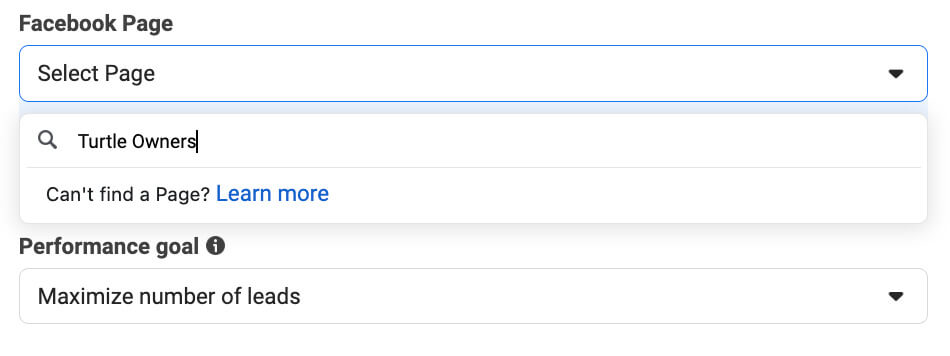
Pick from the options under Optimization & Delivery as well as Budget & Schedule. Facebook will walk you through these options if you hover over the info icon next to each. For example, it'll tell you that lead ads can only be charged per impression. Your budget is how much you want to spend per day, and your schedule is the duration you want your ads to run.
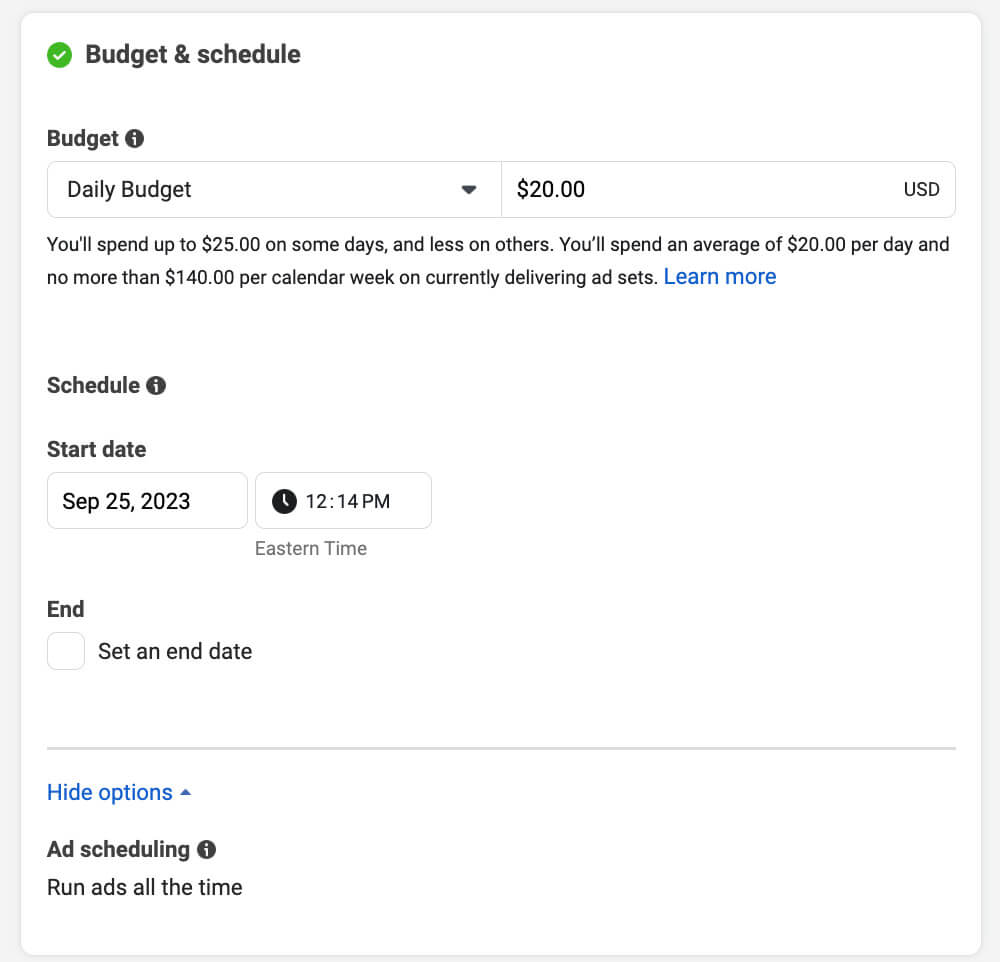
Choose your target audience and placements to decide who sees your ad. You can filter your target audience by demographics, interests, behaviors, and connections. The placements determine where the ad shows up for your audience (e.g., sidebar, news feed, Facebook stories). Click Next when you're finished.
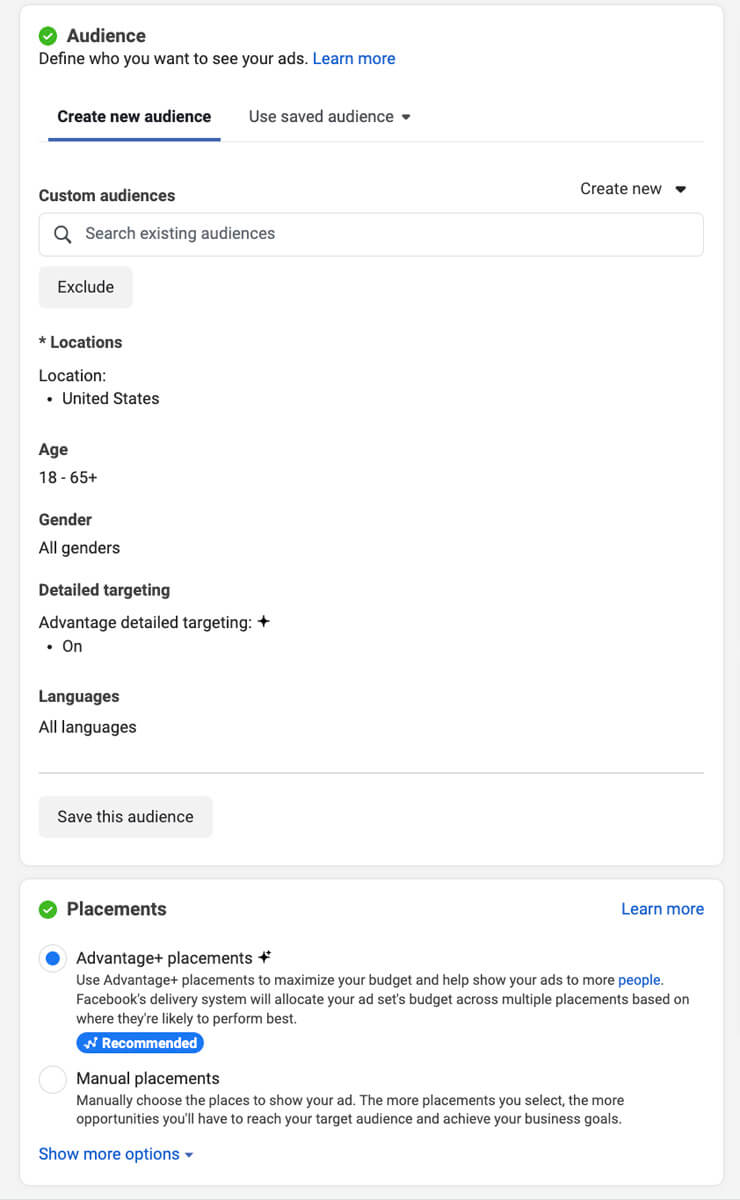
Name your ad, then identify yourself. Here, you can connect the ad to your Facebook page only or also include your Instagram account.
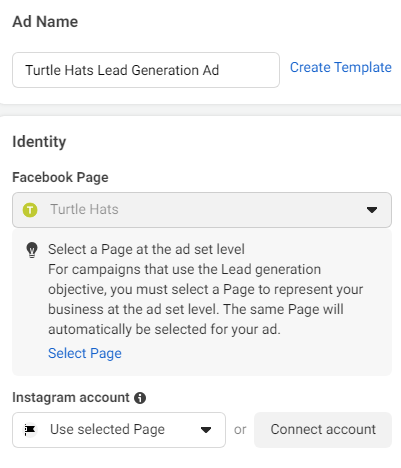
Under Ad Setup, choose your lead ad format. You can select a carousel or a single image or video. Then, scroll down to Ad Creative; here, you can add your media, primary text, headline, and CTA, as well as an optional description and display link. Facebook will recommend lengths for the text boxes, and you'll choose a simple CTA from the dropdown. This ad will be what your audience sees on their news feed.
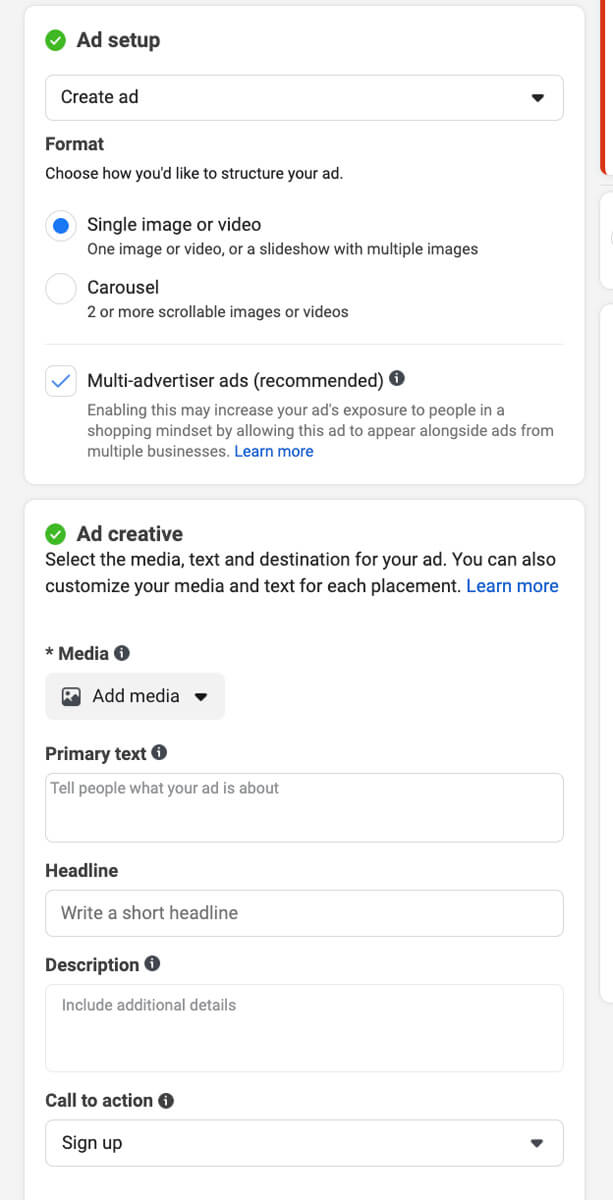
While you fill out the fields above, a window on the right offers a preview of your ad in real time. This way, you can make iterations to decide on the best mix of media and copy.
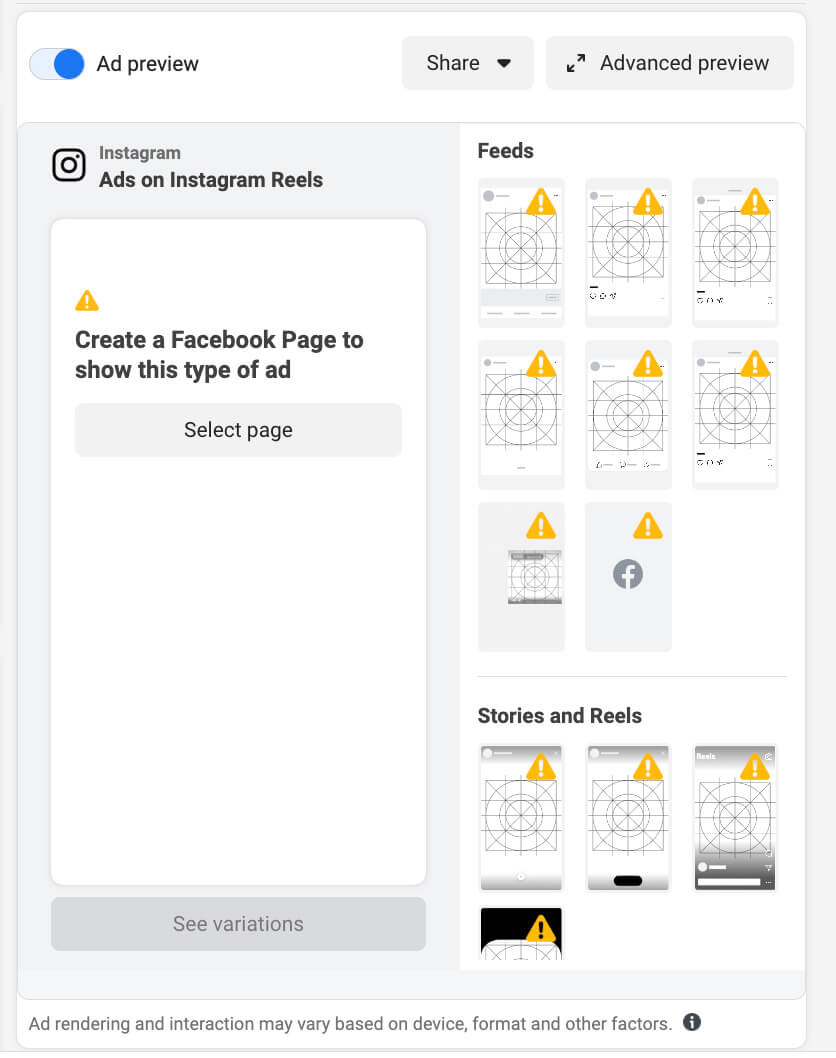
Scroll down and click Create form under Instant Form, as shown below. This window is where you'll create your instant form that will pop up when a user clicks on your ad. It's meant to collect their contact information without making them leave the Facebook platform.
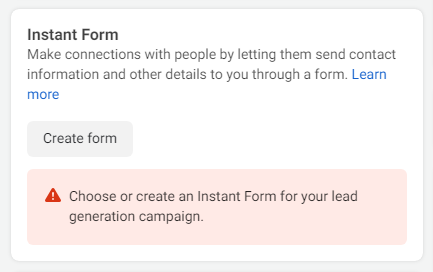
In the Create Form window, there are five dropdown menus you'll complete: the form type, the ad intro, the question fields, your company’s privacy policy, and a thank-you screen. We'll summarize each and share some tips for filling them out.
Under Form Type, you can choose one of two options: More volume or Higher intent. Choose more volume if your goal is to get the form completed by as many people as possible. Higher intent adds a step to your form that prompts people to review and confirm their information before clicking submit.
The lead ad intro in your instant form is an opportunity to share why users should submit the form. Facebook’s short guide recommends using this section to describe what people will receive in return for submitting the form. Here, you can also include a background image that will be shown behind the form.
Question fields represent the information you want to collect from the lead. You can choose from two types of question fields. Prefill question fields (e.g., gender, job title, company name, address) are fields that can autopopulate. Custom question fields are questions you write in yourself. For instance, it could be "number of years as a turtle owner." You can include up to 15 questions, but we recommend keeping it to four or less.
Facebook lead ads require you to link to your company’s privacy policy. Create this page on your business's website if you don’t already have one, and type the link here. You can also include an optional custom disclaimer, such as marketing opt-ins or legal verbiage.
This is the screen that will appear after a user submits the form. Facebook enables you to include a CTA or download link here. Usually, it pays to say thank you and offer them a link to visit your website home page or a specific landing page they'll enjoy.
Click Settings at the top of the Create Form window, and check the box that says Open to allow users to share your form so other potential leads can also complete it. This is an optional advanced step — we recommend it since it helps you gain organic traffic.
Completing these dropdown menus allows you to customize the mechanics of the form, the lead’s experience with the form, as well as some backend privacy settings. Facebook then creates an instant lead generation form to help you collect lead data.
Lastly, in the bottom right, click Save draft or, if you're ready to publish, click Publish. Then you're all done — congrats! After completing these steps, Facebook will review your ad campaign. Typically, the approval process takes less than 24 hours. If you're worried about getting approved or you've been rejected, check out Facebook’s article on how to get ads approved.
Now that you understand the technical aspects of the process, let’s walk through some strategies and tips for optimizing your Facebook lead ads and increasing your success.
Follow these tips to optimize your Facebook lead ads to generate the most and best leads possible. Track your conversions in Ads Manager as you make these optimizations to test for improvements, and continue to iterate.
The audience you target should align with your ad’s objective. For instance, if you sell biodegradable wooden silverware, you should target people with behaviors that indicate a love for the environment. If you're selling memberships to a yoga studio, focus on health-conscious people in your local area. Facebook gives you a wide range of targeting options.
When advertising on Facebook, there are three main types of audiences:
You can also use audience targeting to exclude certain people from seeing your ad. Choose the audiences to exclude when you're setting your audience and placements (step 5 above).
Clearly state what you're offering the user in return for filling out the form. Write this offer in your body ad copy and in the introduction of your lead form.
Also, be sure to include images that back up your words. If you're offering a physical product at a discount, include an image of the product and write the discount in the ad headline. If you're offering a free SEO checklist, include a snapshot of a section of the checklist. Essentially, the image's job is to help users understand what they'll receive.
When your ad form is simple, more people will fill it out. Each field you add decreases the likelihood that a user will complete it. So, we recommended including three to four questions if possible. Figure out what information matters most for your sales process and stick to it.
Keep in mind that the custom questions you include will not autopopulate the lead’s info. Therefore, ask prefill questions when you can, and take advantage of Facebook’s question types when asking custom questions. One popular custom question type is multiple choice, which gives the user a dropdown menu of answers to choose from.
Ad scheduling is a great way to reduce costs by making sure your ads aren’t running while your target audience isn’t actively using the network. For instance, if you sell professional coaching services, your ideal customer probably isn't awake at 3:00 in the morning. Don’t run ads then, because you might waste impressions on bad leads.
However, if you sell a drink that induces sleep and your target audience is people coping with insomnia, go ahead. Remember, you can always test and adjust scheduling.
Famous copywriter Gary Halbert recommends the AIDA technique for creating effective ads. Let’s talk about how to use this technique to get your leads to click on your form.
If you keep this technique in mind while crafting your ad media and copy, you'll likely end up with an effective ad that will bring results.
There are some age-old psychological tactics that still work for grabbing people's attention and influencing them to take action. These include the below:
When possible, try to include all of these in your ad, but find a balance between not offering enough and offering too much (and overwhelming the user).
Let’s go through some examples of ways companies are successfully using Facebook lead ads. Use the best elements from each to create a high-performing ad of your own.
The best examples of quality Facebook lead ads tend to include some combination of an appealing photo or video, a mention of the company's unique selling proposition, the benefits the lead will receive, and an exclusive discount or other special offer.
Facebook uses an auction system for its ads, and the average cost of a Facebook ad across all industries is $0.94 per click or $12.07 per 1,000 impressions — for lead ads, Facebook charges by impressions only. There are certain factors that can affect the price you pay. For example, while it doesn't cost extra to add a form to your Facebook ad, the "lead generation" objective you choose when creating it could come at a higher price than another objective listed as an option.
Specifically, the amount you'll have to bid per lead will depend on the factors below:
The cost you'll pay is variable, but you can bring your cost up or down by using these factors to your advantage. For example, if you don't have to advertise during busy times, plan to make your ad live during other companies' off-season. Allow Facebook to place your ad where it believes you'll get the best results, or choose lower-cost placements on your own. And always make sure to create highly relevant ads for your target audience.
Many of the factors that raise or lower the cost of your Facebook lead ads directly relate to the factors that affect the price that advertisers pay for LinkedIn lead gen forms. If you're a B2B company, consider using LinkedIn lead gen forms once you've mastered Facebook lead ads.
Facebook lead ads provide many benefits to businesses. They help them expand their customer base, generate high-quality leads, and increase brand awareness. Here are some other key benefits of lead ads:
For the right user, Facebook lead ads can be a great option that provides many unique benefits. There are drawbacks to consider, as well, though. Let's look at those next.
Before you dive into creating and publishing Facebook lead ads, be sure you understand the common drawbacks you could experience. The cons of these ads are below:
Despite these disadvantages, Facebook lead ads could be a good fit for you. Consider the pros and cons to ensure you make a well-thought-out decision, then move forward with the lead ads if you decide they could be right for your business. There's little risk involved, so it's a good strategy for most businesses to try out.
It's impossible to edit an existing lead form’s content after you've published it. However, Facebook offers this workaround. Essentially, you can duplicate the form you want to edit, make the edits, and then publish it. If your form is saved as a draft, you can edit it all you’d like. Hover over the form you'd like to edit. Click the Edit button. Then, make any necessary changes and click either Save Draft or Publish. If you're still working on it, click Save Draft; that way, you can return to finish it later.
Facebook lead ads are relatively inexpensive and easy to set up. Regardless of your specific business objectives, lead ads can help your company target high-quality leads. What matters most when creating them is your ability to align your messaging and offer with your audience. For more insight into how to attract leads, read our complete guide to lead generation, where we give you more lead generation ideas and offer the ideal software to help you along the way.
This article was written by Sam Rinko and updated by Allyssa Haygood-Taylor.